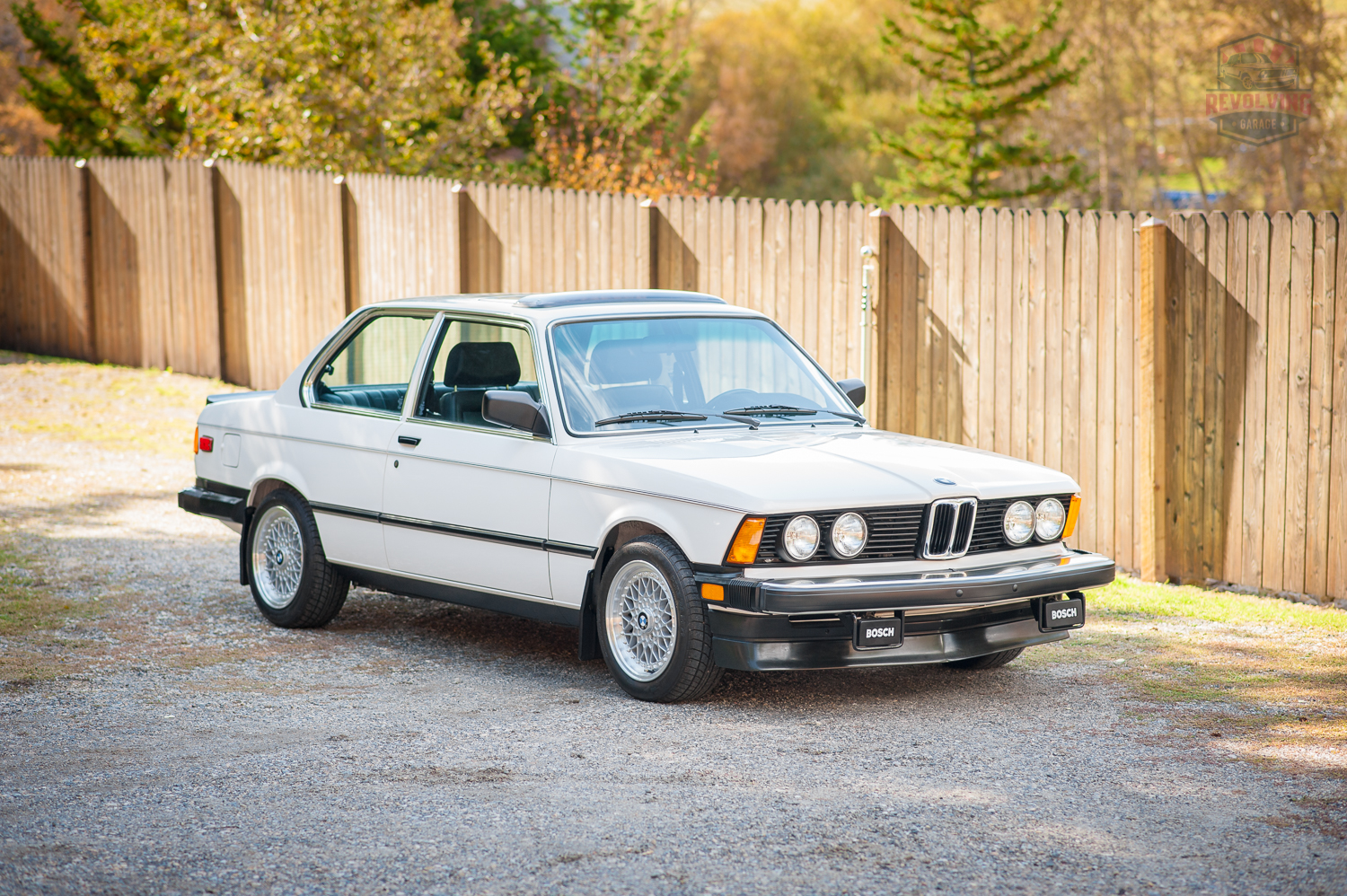
By Dan and Christian
Years ago a friend gave me a copy of a cookbook of sorts, called Manifold Destiny. (Find it here). The premise of the book is that you can cook food using heat generated from your engine. As much as I appreciate that kind of adventurous spirit, I’ve never been able to get past the vision of a beautiful piece of beef sizzling in a melange of oil and road dirt on a filthy engine manifold. That was, until I saw this BMW 320iS. This car is so clean it has upended my entire comfort level with eating off of used car surfaces. And I’m not just talking about the clean paint on this thing. I’m talking about eating your morning cereal out of the trunk lip; cooking a roast in the spare tire well; or using the inside rim of a wheel as a cheese plate. This thing is that clean.
But it’s not just the cleanliness that boggles the mind. It’s that this is also an un-restored and period correct car. There are fully restored museum pieces with a permanent perch behind velvet ropes that would probably pass most county health codes. But there aren’t many original examples that would. Feast your eyes, and perhaps your stomach, on the vision that follows:




To be clear, when I say “original” and “period correct” I mean that the car has never been restored, or even retouched. It is not, however, presented as it was on the day of delivery. It has a buffet of fantastic tuner parts on it from the early 1980s, and sitting nearby are all the pieces to return it to delivery spec. It began its life on an assembly line in Germany around October of 1981. The current owner picked it up from Peterson Motor Company, in Boise, Idaho in June of 1982. He still has all the original paperwork. Part of the reason for it’s immaculate condition is that it has lived in the dry and ferrous friendly open expanses of the mountain west its entire life. The other reason is that the owner really only drove the car with day to day intent for about a year, and less than 8,000 miles at that. He then took it out of his regular rotation, although to be clear it has been started and driven regularly, if sparingly, since that time.
The modern BMW story starts with the “Neue Klasse” sedans and coupes of the 1960s and 70s, as well as a designer by the name of Paul Bracq. The Neue Klasse cars incorporated several elements that would carry through BMW cars for decades, including the subject here. Notably, these were the first BMW sedans and coupes to feature the now trademark “Hofmeister Kink” at the rear window. They were traditional three box designs with a tall flat roofline and generous greenhouse, but with sporty elements such as the forward rake of the front grill, and prominent kidney grills. With fully independent suspension, unit body construction, and front disks, they weren’t the bleeding edge of technology, but they were far sportier than most sedans of the day. The sport sedan would eventually become a calling card of BMW in the 80s, 90s and beyond. An article unto itself should be written about the designer of the E21, Paul Bracq. After working at Mercedes and penning the W115 (featured on Revo here), he created many iconic BMW designs including the E21, the "shark nose" E24 6-Series, the M1 prototype, and of course the BMW 2002.
The 2002 coupes that followed the Neue Klasse in the U.S. were many American’s first exposure to BMW. They were quite a contrast to the muscle cars of Detroit: light, nimble, with modest but sufficient power. They were popular then as they are today, although never selling in huge numbers in the ‘States. The 2002 was a brilliant if slightly crude platform that could have evolved into a performance car with sophistication. But geopolitics and an energy crisis would come to dominate car engineering of the late 1970s and early 1980s, including the successor to the 2002. BMW branded it the 320i, and enthusiasts often refer to it as the E21.
The model you see here is a 1982 BMW 320i with the “S” package fitted. Technically speaking it was not sold as 320is, as later three series would be labeled. Instead the S was a package added to the fuel injected 320i. This was a special package with both visual and performance cues. Some sources put total S package production at 2,500 through its offering from ‘80 through ‘82. The package included:

- Body color in white, black, red or silver only
- “Debadged” trunk lid (still had Roundel)
- 5-speed manual transmission with O/D final gear
- Limited slip rear differential
- Rear sway bar added; larger front sway bar
- Special Honeycomb 13” alloy wheels (13x5.5)
- Front air dam
- Bosch fog lights
- Recaro sport seats in black leatherette
- Sport steering wheel
- Sun roof
- Large 'Senior Six' trunk tool kit
- A/C delete
Power remained the same with the S package. Barely 100 HP was delivered from the 1.8 liter 4 cylinder M10(B18) engine with Bosch K-Jetronic (lambda) fuel injection.
This paucity of power was the jumping off point for the owner of this example. He longed for a car that was not only more sophisticated than the 2002 (as was the E21), but just as fun to drive. He needed more power, and more performance. The tuner market at the time agreed. Turbo charging was not yet a wide-spread technology in the consumer market, but seemed to be the answer to getting the 50 or so more ponies needed out of the emissions choked motor. Unfortunately, many of those kits required complex rebuilds of engine internals to reduce pre-boost compression and handle the power. Not to mention the complicated interplay between early mechanical fuel injection, and the increased fueling needs of the turbo. Enter Hardy & Beck. No, it’s not a late ‘60s comedy show, and it’s not the newest hipster bar with hand crafted and sustainably harvested cocktails, it’s the name of a BMW service shop in Berkeley, California that for several decades through the ‘90s became one of the premier BMW tuner shops, sort of the Dinan of yesteryear. Parts were branded “H&B,” and incredibly H&B is still in business as “Berkley Auto Repair” and “H&B.” A quick search through the BMW forums shows that both original owners, while no longer in business together, are still accessible to the community and support for H&B parts is still available.
While H&B made a variety of performance parts for several models of BMW, the one we care about here is the H&B TK31 Turbo System. What attracted the owner, along with H&Bs top notch reputation, was that it did not need internal modifications to the engine, and had a secondary fuel management system that worked with the K-Jetronic and prevented fuel starvation leading to premature detonation and engine damage. While he has never dyno’d the car, the owner believes that H&Bs claim of 45 additional ponies is spot on. And it’s just the right amount to take the E21 320i from malaise, to spicy mayonnaise.
While the turbo kit is the game changer, the car also currently sports:
- H&R springs that lower ride height about 1 inch;
- Bilstein sport shocks;
- Adjustable rear trailing arm kit (for camber adjustment);
- Korman 15x7 “Speedline” alloy wheels with Bridgestone RE71 tires;
- Ferodo high performance brake pads and shoes;
- Rubberized rear trunk spoiler;
- H&B 3 gauge instrument cluster (oil pressure, oil temp, and boost); and
- Many other miscellaneous items.

Along with all of the stock parts, there are also a few additional period correct parts that could be added, including:
- Metric Mechanic Sport Ultimate transmission with O/D (still in the crate);
- Sachs high performance clutch package, with Metric Mechanic lightweight flywheel; and
- Euro spec 323i rear disc brake upgrade.
How’s it drive? Well, with 8,100 odd original miles, I’ll probably never find out. So we’ll have to ask the owner to describe it in his own words:
"My brother had '72 BMW 2002, and that car probably set me on the path of acquiring a great driving and sophisticated German coupe. So thanks to him for setting me on this journey. And while I admired much about the 2002, I also thought perhaps I could find something with a different look, but that was also a great driver. Enter the E21 320i.
The car drove and handled nicely right out of the box, nearly matching the performance of the much loved 2002 cult car but with a more civilized intention; as in more creature comforts (like a heater that actually worked). Still frustrated with that ‘buzzy’ 1.8l M10 engine of 100 ponies, I decided it needed about 40 to 50 more, including coordinated upgrades on the rest of the car. Hello period tuners! The result netted me a more performance oriented version of an already civilized sport sedan of the day. These cars solidified BMW’s promo tag ‘The Ultimate Driving Machine’ in true 1980’s style.
In terms of performance after the modifications, the car is an absolute hoot to drive. Upon the very first drive, once that secondary fuel management system was correctly dialed-in, I recall my face cracking over a big smile once that turbo wound up. Holy crap I screamed and nobody heard me! Now with a more reasonable HP to weight ratio I had a US spec E21 that approached the performance of its Euro 323i 6-cylinder sibling that we never saw stateside and I was finally able to smoke those boxy 2002’s. I also found the car especially nimble and competitive in a few local SCCA auto-crosses; and gone was the frustrating inside rear wheel lift of yesteryear. The car will likely see another car show or two or perhaps even an auto-cross, before I say goodbye and send it along to the next custodian."
With body work you can eat off of, a perfect blend of rare factory S pack, period tuner parts, and lots of originality, this car is truly a German Performance Buffet. A Smorgasbord, if you will.












































